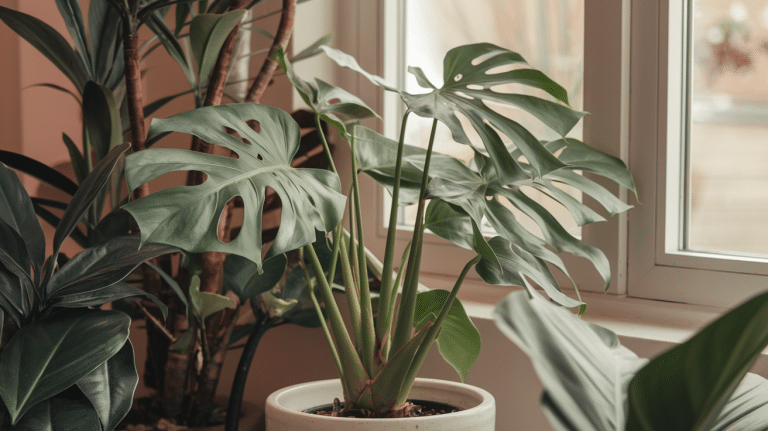If you want a houseplant that stands out but doesn’t take over your space, the Little Swiss Monstera is a good pick.
This is a plant that works in any room of the house, especially the rooms that have great moisture. The best shower head filter can make the water purer an that means that the steam in the bathroom will help to feed your house plants the best water! It’s important that you pick things for your home that make good sense, and plants? Well, they always make sense.
It has holey leaves, grows fast, and can climb, trail, or hang depending on how you set it up.
This guide covers what you need to keep it healthy: light, water, soil, pruning, and basic care.
I’ll also walk through common problems, how to fix them, and how to grow more plants from cuttings.
If you’re unsure what this plant needs or how to get started, you’ll find clear steps here.
Getting to Know Your Little Swiss Monstera
The Little Swiss Monstera features arrow-shaped green leaves with distinctive natural perforations along the veins.
These holes are not damage – they’re a natural adaptation that gives the plant its special character.
As a medium to fast-growing vine, it starts small but can become quite impressive over time.
Young plants work perfectly for desks and small spaces, while mature specimens can develop leaves up to 24 inches long when properly supported.
The plant grows as a climber in nature, using aerial roots to attach itself to surfaces as it reaches upward toward the light.
Where it Comes From
This plant is native to tropical forests, where it grows up tree trunks and along branches.
In these environments, it receives filtered light through the forest canopy and enjoys consistent humidity.
Understanding its origins helps explain why it prefers bright, indirect light and appreciates extra moisture in the air.
The climbing growth habit also shows why providing support helps the plant develop its most impressive form.
Creating the Right Light Environment
Light requirements are crucial for your Little Swiss Monstera’s health:
- Best growth occurs in medium to bright indirect light
- Direct sunlight can burn the leaves, especially during midday hours
- Too little light causes slow growth and stretched stems
- The plant can adapt to lower light but won’t thrive there
- Artificial light works well if natural light is limited
A simple way to gauge light levels: If you can read comfortably without additional lighting, that’s low light.
A soft shadow indicates medium light, while a clear, defined shadow means bright light.
Mastering the Watering Schedule
Finding the right watering balance keeps your plant happy:
- Let the top 2 inches of soil dry between waterings
- Check soil moisture with your finger before adding water
- In winter, extend the time between waterings as growth slows
- Drooping leaves often signal thirst
- Soft, yellowing leaves typically indicate overwatering
These plants are more tolerant of drying out than sitting in water. When in doubt, wait another day or two before watering.
Managing Air Moisture and Temperature
The Little Swiss Monstera can handle regular indoor conditions, but it does best when the air feels a bit like its natural home.
These tropical plants prefer moderate to high humidity and temperatures between 60°F and 85°F (15°C to 29°C).
Try to keep them away from chilly drafts or spots where the temperature changes quickly.
If your home tends to be dry, you can help by placing your plant near others or running a small humidifier close by.
Even though extra moisture in the air is helpful, many homes already provide enough without needing to do much.
A little attention to comfort goes a long way in keeping your plant happy.
Selecting the Perfect Growing Medium
Your plant’s root health depends largely on its soil:
- Choose a lightweight, well-draining potting mix
- Standard indoor plant soil with added perlite works well
- Look for a mix that holds some moisture without becoming soggy
- Select containers with drainage holes
- Choose pots just slightly larger than the root system
A good homemade mix combines 2 parts quality potting soil, 1 part perlite, and 1 part orchid bark for improved drainage and aeration.
Feeding Your Little Swiss Monstera Properly
The Little Swiss Monstera doesn’t need a lot of feeding to stay healthy.
During spring and summer, when it’s actively growing, you can give it a regular houseplant fertilizer—but only at half the usual strength.
Once a month is enough. Avoid feeding it in fall and winter since the plant slows down and doesn’t use up as many nutrients.
Too much fertilizer can actually harm the roots and cause the tips of the leaves to turn brown.
Keeping the feeding simple and light is the best way to go. This plant does just fine with a gentle approach, so it’s better to use less than to overdo it.
Supporting Your Climbing Plant

As your Little Swiss Monstera grows, it can benefit from a bit of support.
When the plant is small, it looks great hanging from baskets or trailing down a shelf. But as it gets bigger, it starts looking for something to climb.
This is a good time to add a moss pole, trellis, or plant stake. These options help guide the plant upward and keep it stable.
Just make sure to secure the stems gently using soft ties that won’t damage them.
Over time, the aerial roots will start grabbing onto the support on their own.
Giving your plant something to climb helps it grow in a more natural way and often leads to fuller leaves.
Maintaining Shape and Fullness
Regular trimming helps your Little Swiss Monstera stay healthy and neat.
Cutting back long stems encourages the plant to grow more branches, which makes it look fuller.
If you see any yellow or damaged leaves, gently remove them to keep the plant looking fresh.
Always cut just above a node—the spot where a leaf grows from the stem.
Be sure to use clean, sharp scissors or pruning shears to avoid harming the plant. If the cuttings are healthy, you can even use them to grow new plants.
A bit of occasional trimming can make a big difference in how your plant looks and grows over time.
Understanding the Growth Cycles of Little Swiss Monstera
Your Little Swiss Monstera follows a simple and natural rhythm throughout the year.
It grows most during spring and summer, when you’ll notice fresh leaves starting out tightly rolled before they open up.
At first, younger leaves might have fewer holes, but that changes as the plant matures.
As fall and winter arrive, growth naturally slows down. During this time, the plant may rest and focus less on producing new leaves.
It’s also normal for older leaves to drop off now and then, especially when new ones are on the way. With steady care and the right conditions, your Monstera will keep rewarding you with new growth in its active seasons.
Tackling Common Care Challenges
Even well-cared-for plants sometimes develop issues:
- Yellowing leaves: usually means too much water
- Brown leaf: edges suggest dry air or excessive light
- Stretched: leggy growth indicates insufficient light
- Small new leaves: might signal poor nutrition
- Leaves without holes: often need more light
Most problems are resolved with simple adjustments to light, water, or humidity.
For mild problems, wiping leaves with soapy water often works. Persistent issues may require insecticidal soap or neem oil applications.
How I Make More Plants (for Free)
Propagating this plant is fun and surprisingly easy—I’ve made a few new plants just by snipping and rooting. Here’s what works for me:
- Cut a stem with at least one node (that little bump where roots will grow)
- Keep 1–2 leaves on the cutting
- Pop it in a jar of water or moist potting mix
- Roots usually show up in 2–4 weeks
- Once the roots are about 1–2 inches long, plant it in the soil
Water propagation is cool because you can see everything happening. But if you’re after stronger roots from the start, soil’s the way to go.
Creative Display Options

The Little Swiss Monstera is easy to style in any space. Small ones look great on desks or shelves.
Hanging baskets show off its trailing vines. Use a moss pole for a taller look.
You can also group it with other tropical plants for a full, green display. Its holey leaves let light peek through, adding soft patterns and texture to your room.
Perfect Plant Partners
These plants complement Little Swiss Monstera well:
- Moonlight Scindapsus offers contrasting leaf shapes
- Golden Goddess Philodendron adds color variation
- Shingle Plant shares similar care needs
Plants with similar light and water requirements make maintenance simpler. Creating plant groupings with similar needs simplifies care routines.
Final Thoughts
We’ve covered everything you need to care for your Little Swiss Monstera, from light and water needs to styling tips and common care reminders.
This guide was built to help you feel more confident, no matter your plant experience.
You now know how to support healthy growth, keep your plant tidy, and bring out its best features.
What matters most is that you enjoy the process. Every plant grows a little differently, and part of the fun is learning as you go.
If you stay patient and keep an eye on what your plant needs, you’ll build a routine that works for both of you. Simple steps, steady care are all it takes.














One Response
TY so much for all the very thorough information.